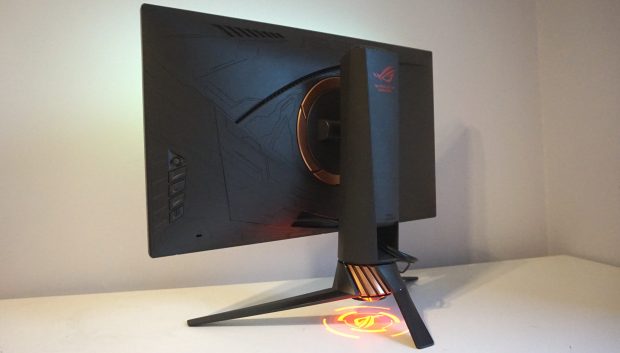
There’s one thing faintly ridiculous concerning the Asus ROG Swift PG258Q. Maybe it’s the actual fact it has a glowing pink Asus ROG mild popping out of its elevated, three-pronged stand. Maybe it’s the colossal 240Hz refresh fee. Or possibly it’s the worth, which most retailers at present have pegged someplace around the £500 mark (or $513 if you’re in the US). That’s a good bit of money for a 25in 1920×1080 display, particularly when the Acer XF270HUA provides you a 27in, 144Hz 2560×1440 show for a similar cash. Nah, on second thought, it’s positively the sunshine.
Thankfully, its so-called ‘Light in Motion’ characteristic isn’t a everlasting fixture on the PG258Q and could be simply switched off in its onboard menu controls. But for all six of you who actually dig this type of factor, you’ll be happy to listen to there’s not one, however three totally different mild intensities you’ll be able to choose for max gamer cred amongst your mates.
In all honesty, although, the raised stand and base do really look fairly fashionable in your desk, and its bronze twisted metallic design makes a refreshing change from the angular slabs you usually discover on closely branded gaming displays. Round the again, it will get even neater, as the general design doesn’t simply match Asus’ eye-like ROG brand, however there’s additionally a cheeky removable plastic panel you’ll be able to pop on to cover your DisplayPort, HDMI and USB cables – and that’s along with a small cavity within the stand itself. Throw in all the standard ergonomic treats you’d anticipate on a high-end monitor like this (peak adjustment, tilt, swivel and rotation) and the PG258Q makes an ideal first impression.

On the Asus PG258Q, you get one DisplayPort, one HDMI and two USB3 ports.
Like its PG248Q predecessor, the PG258Q comes with a number of color profiles and an intuitive menu system that will help you get a superb image. Fortunately, its 25in 1920×1080 TN panel produced fairly nice outcomes straight out of the field, so that you shouldn’t should spend lengthy twiddling with the settings.
Annoyingly, the sRGB mode – arguably essentially the most balanced profile of the lot – is totally locked down by way of adjustment, so you might wish to change to one of many different modes should you do wish to make any adjustments. The sRGB mode nonetheless returned good outcomes, although (93.three% of the sRGB color gamut in comparison with the 94.three% I managed to get on the FPS mode after just a few alterations to the color temperature), so it ought to suffice for each gaming and normal computing duties with out a lot effort in your half.
It’s additionally actually, actually fairly brilliant, hitting a powerful 512cd/m2 at its peak. That’s too intense for extended use except you’re utilizing it in direct daylight, so that you’ll want to regulate it to a stage that doesn’t make your eyes bleed, however at the least there are many blue mild filters readily available to assist lower down additional on any potential eye fatigue.

With the again panel connected, the PG258Q really appears to be like fairly sensible – save the pink ROG mild…
The important draw back of getting such a brilliant display is that black ranges undergo because of this, leaving darker areas of the display trying a bit gray and washed out. I wouldn’t thoughts a lot if the distinction stage was a bit greater, however my measurement of 949:1 left me a little bit underwhelmed. It’s not horrible, but it surely’s trumped as soon as once more by the superior Acer XF270HUA, which produced a smoother gradation from black to white as a substitute of seen chunks of gray just like the PG258Q.
Where the XF270HUA can’t contact the PG258Q is the refresh fee. Whereas the XF270HUA maxes out at 144Hz, Asus permits you to flip all of it the way in which as much as 240Hz, basically giving your graphics card(s) free rein to go bananas with the body fee, and actually take advantage of its Nvidia 3D Vision tech should you occur to personal the mandatory 3D glasses. Admittedly, even the GTX 1080 tucked away inside MSI’s monstrous GT75VR laptop struggled to go a lot above 200fps on Low in Doom, so except you’ve bought a dual-graphics card setup in your present rig, it’s unlikely you’ll be capable to make use of all these further refreshes.
Still, even when your present card isn’t fairly as much as the duty of doing that proper now, you’ve nonetheless bought loads of headroom for in a while while you finally come to improve, making it a superb little bit of future-proofing down the road. Likewise, the additional G-Sync help may also assist stop Nvidia card house owners from experiencing any sudden body fee dips should you do occur to stretch a little bit past your means, making certain easy, tear-free gaming no matter refresh fee you’re utilizing.
For my cash, I believe I’d nonetheless moderately get the Acer XF270HUA, because it has a greater general panel and a bigger decision. However, in case your aim is to play video games at 1080p at the very best they’ll probably be (and fancy a free copy of Assassin’s Creed Origins from CCL), then the PG258Q remains to be a good selection, significantly should you’ve bought an Nvidia graphics card, and I’d positively advocate it over Asus’ PG248Q – simply don’t anticipate any sympathy if anybody occurs to clap eyes on these pink LEDs. For these trying to save a bit of cash on excessive body fee gaming, nevertheless, then the AOC G2460PF remains to be my high decide for these on a price range.


